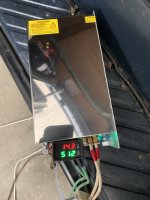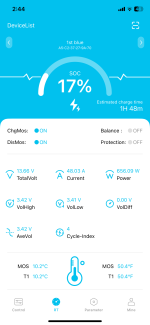Well, the project is finally "Done" done.
Obviously having to connect the 120vAC battery charger to the camper using alligator clips was not a viable long-term solution. I didn't want to have to pop the top off my battery cover every time I charged them so I made a small "pigtail" with a couple of ring terminals and an Anderson connector that will hang outside the battery box and allow me to keep the battery box closed and locked (double padlocked.)

Of course, this meant that I could no longer connect the charger to the batteries using the alligator clips so I snipped them off and put an anderson connector on the charger.

But, since I could envision sometimes needing the alligator clips, I went ahead and put them on an Anderson connector as well. So if I need alligator clips, I'll just click them onto the connector on the charger. I hooked it up to "bench test" and make sure it worked.

26.2 amps going into the battery.
Next it was time to hook up the whole system with the inverter. Here I ran into a curious situation.
Here's a photo of the charger. It's hard to see due to the sunlight, but the charger is showing that it's putting out 29.9
A to the two batteries:

And yet...when I pull up the BMS app on my phone, this is what I see:

Now previously when I tried this setup, I was getting 15A to each battery, which makes sense since the charger is a 30A charger.
But only showing 10A when the charger shows that it's putting out a full 30A was puzzling to me. Literally the only thing I did differently was use Anderson connectors.
After about 8 minutes the result was still the same: The batteries were only receiving just under 10A while the charger was putting out the full 30A:

I racked my brain trying to figure out what happened. Had I failed to tighten up one of the bolts? Was a loose bolt causing the amp loss? I even felt the cable with my hand to see if it was heating up, thinking that energy had to be going somewhere.
I decided I would have to open up the battery box to check the connections. But I didn't want to do it today because it was SO DAMN COLD OUTSIDE! It only got up to about 18f (-8c) yesterday, just bitter cold. My hands were numb and I was tired of being outside so I said "I'll check it when it warms up."
It wasn't until I was getting ready for bed that I realized something: These are SELF HEATING batteries. The display showed a battery temperature of 10c/50f but in fact it was well below freezing outside.
So my conclusion is that the reason the batteries were not getting the full 30A of charge is because a portion of that energy was being bled off to keep the batteries warm with the built in self-heater.
It's another bitter cold day today, but it's supposed to start warming up tomorrow. Once the weather gets above freezing, I'll check the charging capacity again, my guess is that it will go back to the batteries able to get a full 30A out of the charger once the self-heaters aren't being used.








